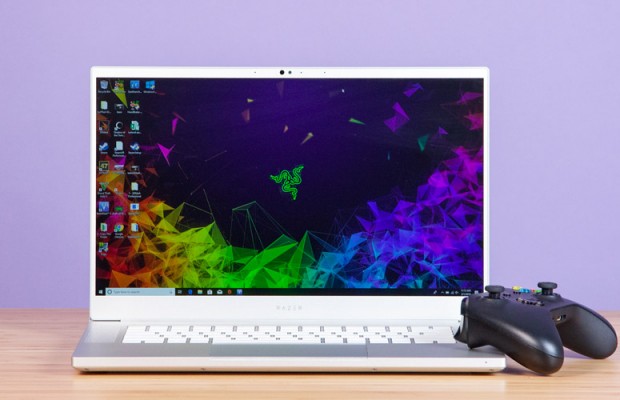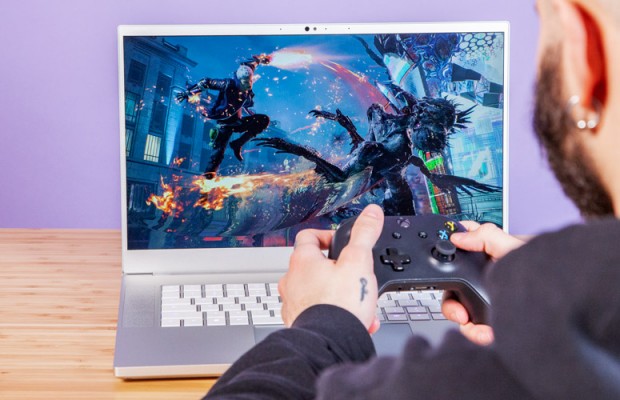Gigabyte Aero 15 Classic vs. Razer Blade 15: Which RTX Gaming Laptop Is Best?
Razer is the king of superthin gaming laptops, and its recent refresh of the Razer Blade 15 (tested at $2,649; starts at $1,599) only further proves that. However, a new challenger appears, with Gigabyte throwing the Aero 15 Classic (tested at $2,499; $1,799 starting) into the arena, an RTX gaming laptop backed by the power of Microsoft's Azure AI.
The Razer Blade 15 is hard to beat with its vivid display and slim profile, but Gigabyte does not pull any punches whatsoever, with the Aero 15 boasting excellent overall performance and battery life.
Here's how these two premium gaming laptops stack up.
Gigabyte Aero 15 Classic vs. Razer Blade 15: Specs Compared
| Row 0 - Cell 0 | Gigabyte Aero 15 Classic | Razer Blade 15 |
| Starting Price (as configured) | $1,799 ($2,499) | $1,599 ($2,649) |
| Colors | Black | Mercury White (Black available) |
| Display | 15.6 inches, 1920 x 1080, 240Hz (3840 x 2160 available) | 15.6 inches, 1920 x 1080, 144Hz (3840 x 2160 available) |
| CPU | Core i7-9750H (Core i9 available) | Core i7-8750H (Core i9 available) |
| RAM | 16GB (64GB available) | 16GB |
| SSD | 256GB, 512GB, 1TB, 2TB | 256GB, 512GB |
| Graphics | Nvidia GeForce RTX 2070 Max-Q (GTX 1660 Ti or RTX 2060/2080 available) | Nvidia GeForce RTX 2070 (GTX 1060/RTX 2080 available) |
| Ports | Three USB 3.1, one Thunderbolt 3, HDMI 2.0, USB Type C DisplayPort 1.4, RJ45, security lock slot, headphone jack, SD card slot | Three USB 3.1, one Thunderbolt 3, HDMI 2.0, Mini DisplayPort 1.4, security lock slot, headphone jack |
| Size | 14.0 x 9.8 x 0.74 inches | 14 x 9.3 x 0.7 inches |
| Weight | 4.6 pounds | 4.7 pounds |
Design
The Aero 15 and Razer Blade 15 are both sexy, slim machines that sport aluminum chassis. While the Aero 15 attempts to stand out with its carbon-fiber accents on the hood, it just looks like plastic compared with the Razer Blade 15's premium Mercury White design.
On the interior, the Aero 15 features an edge-to-edge keyboard that's accompanied by a numpad, thin bezels on the display and a webcam on the hinge. On the flip side, the Razer Blade 15 has a smaller keyboard but fits two top firing speakers on the deck as a result, and its display manages to retain slim bezels while also keeping the webcam on the top. The black-on- black found on the Aero 15's deck and keyboard doesn't catch the eye as much as the Razer Blade 15's white-on-silver aesthetic.
Sign up to receive The Snapshot, a free special dispatch from Laptop Mag, in your inbox.
The Razer Blade 15's design (4.7 pounds; 14 x 9.3 x 0.7 inches) is clean-looking and more compact than the Aero 15 (4.6 pounds; 14.0 x 9.8 x 0.74 inches). Gigabyte's laptop has a larger footprint due to its extended keyboard.
Winner: Razer Blade 15
Ports
Between the Aero 15 and the Razer Blade 15, there's a slight difference in ports. The Aero 15 has three USB 3.1 ports, one Thunderbolt 3 port, an HDMI 2.0 port, a USB Type C DisplayPort 1.4, an RJ45 port, a security lock slot, a headphone jack and an SD card slot.
The Razer Blade 15 has similar ports, but ditches the RJ45 port and SD card slot while replacing the USB Type-C DisplayPort 1.4 with just a regular Mini DisplayPort 1.4.
Winner: Gigabyte Aero 15 Classic
Buy the Gigabyte Aero 15 Classic
Display
Both the Aero 15 and the Razer Blade 15 have 15.6-inch, 1920 x 1080 panels with high refresh rates. However, the Razer Blade 15's display caps out at 144Hz, while the Aero 15 breaks that barrier with 240Hz. There is a Razer Blade 15 configuration that features a 240Hz display.
Despite that, the Razer Blade 15 killed it when it came to color and brightness, as its display covered 149% of the sRGB spectrum and emitted 262 nits of brightness. The Aero 15 trailed Razer on both tests, with 117% of sRGB and 246 nits.
The Aero 15 gets a small win on color accuracy, however. Its panel had a Delta-E of 0.13 (lower is better), besting the Razer Blade 15's 1.25.
MORE: Best Gaming Monitors: Top Picks for 1080p and 4K Gaming
Overall, the Razer Blade 15's vivid color takes the win.
Winner: Razer Blade 15
Keyboard and Touchpad
In terms of pure functionality, the Aero 15 offers more due to its full-size numpad. But if you'd prefer typing at the center of the chassis, then the Razer Blade 15 might be for you.
As far as the keys go, the Aero 15's have deeper travel, at 1.8 millimeters, and require more force to actuate, at 75 grams. The Aero 15's keyboard stays within our comfort zone of 1.5 to 2.0 millimeters, unlike the Razer Blade 15's, which came in at 1.2 mm. However, the Razer Blade 15's keys did exceed the minimum 60g of force that we look for with 68g.
The Aero 15 and Razer Blade 15 both have software that can customize the perkey RGB lighting on the keyboard.
You do get more real estate on the Razer Blade 15's touchpad, which measured 5 x 3 inches, compared with the Aero 15's 4.1 x 2.7-inch touchpad.
Winner: Gigabyte Aero 15 Classic
Gaming, Graphics and VR
These beastly gaming laptops are both armed with an Nvidia GeForce RTX 2070 Max-Q GPU with 8GB of VRAM, and while the Aero 15 has the power of Microsoft's Azure AI on its side, it slightly underperformed the Razer Blade 15 on our benchmarks.
On the Rise of the Tomb Raider benchmark (Very High, 1080p), the Razer Blade 15 nailed a solid 60 frames per second, which grazed by the Aero 15's 55 fps.
The Aero 15 took the lead ever so slightly on the Hitman benchmark (Ultra, 1080p), scoring 98 fps, just climbing over the Razer Blade 15's 96 fps.
Despite that, the Razer Blade 15 took the lead again by one single frame on the Grand Theft Auto V benchmark (Very High, 1080p), which averaged 76 fps versus the Aero 15's 75 fps.
On the Middle-earth: Shadow of War benchmark (Ultra, 1080p), the Razer Blade 15 created the widest gap, scoring 91 fps versus the Aero 15's 87 fps.
While both systems traded consistent blows, the Razer Blade 15 came out on top by a small margin on most tests.
Winner: Razer Blade 15
Performance
The Aero 15's 9th Gen Intel Core i7-9750H processor propels it toward glory, showing the age of the Razer Blade 15's previous-generation Intel Core i7-8750H processor.
On the Geekbench 4.1 overall performance test, the Aero 15 scored 23,516, flying past the Razer Blade 15's 22,379.
MORE: Best Gaming Laptops
The Aero 15 created the widest gap on our HandBrake benchmark, which requires transcoding a 4K video to 1080p. Gigabyte's notebook took just 10 minutes and 4 seconds to transcode, while the Razer Blade 15 performed the test in a slower 12:53.
Even the Aero 15's 512GB SSD was faster, as it copied 4.97GB of files in just 7 seconds, translating to 727 megabytes per second. That's more than 100 MBps faster than the Razer Blade 15's 512GB SSD (636 MBps).
Winner: Gigabyte Aero 15 Classic
Battery Life
As far as RTX gaming laptops go, these two machines are the champions of battery life, but there can be only one true king. After the Aero 15 continuously surfed the web over Wi-Fi at 150 nits of brightness, its battery lasted 6 hours and 58 minutes. That topples the Razer Blade 15’s 5:02 nits by nearly 2 hours.
Winner: Gigabyte Aero 15 Classic
Value and Configurations
Regarding value, the Aero 15 and the Razer Blade 15 are both pricey, but equally so. The Razer Blade 15 has lower-tiered configurations, but the Aero 15 has more flexibility with beefier components.
The Aero 15 Classic that I tested costs $2,499 and comes with an Intel Core i7-9750H processor, an Nvidia GeForce RTX 2070 Max-Q GPU with 8GB of VRAM, 16GB of RAM, a 512GB SSD and a 1920 x 1080, 240Hz display.
MORE: The Best Games (So Far)
The Mercury White Razer Blade 15 we tested costs $2,649 and is outfitted with a Core i7-8750H processor, 16GB of RAM, a 512GB SSD, an RTX 2070 Max-Q GPU and a 1920 x 1080, 144Hz panel. Oddly, it costs the same amount for the 9th Gen Core i7, 240Hz model. The black version runs $2,599 for both configurations as well.
Meanwhile, the Aero 15 base model goes for $1,799 and drops you to a Intel Core i7-9750H processor, 16GB of RAM, a GTX 1660 Ti GPU and a 1920 x 1080, 144Hz display. The Razer Blade 15 starts at a cheaper $1,599, but strips down to a Core i7-8750H processor, 16GB of RAM, a GTX 1060 Max-Q GPU, a 128GB SSD, a 1TB HDD and a 1920 x 1080, 60Hz panel.
MORE: Gaming Laptops and Accessories - News, Reviews and Best Picks
Maxing out the Aero 15 will cost a whopping $4,449 and get you a Core i9-9980HK CPU, an RTX 2080 Max-Q GPU, 64GB of RAM, a 2TB SSD and a 4K display. On the flip side, the capped out Razer Blade 15 costs $3,299 and offers a Core i7-9750H, an RTX 2080 Max-Q, 16GB of RAM, a 512GB SSD and a 4K OLED display. For a similar price, at $3,199, the Aero 15 offers a Core i7-9750H, an RTX 2080 Max-Q, 32GB of RAM, a 1TB SSD and a 1080p, 240Hz display.
While the Razer Blade 15 has a cheaper base model, it doesn't offer anything more than 16GB of RAM and a 512GB SSD, which is nuts considering that with the Aero 15 you can get up to a 2TB SSD and 64GB of RAM.
Winner: Gigabyte Aero 15 Classic
Bottom Line
After a hard-fought battle, the Gigabyte Aero 15 Classic scrapes its way to victory over the Razer Blade 15, topping it on ports, keyboard, overall performance, battery life and even configurations.
| Row 0 - Cell 0 | Gigabyte Aero 15 Classic | Razer Blade 15 |
| Design (10) | 6 | 9 |
| Ports (10) | 9 | 7 |
| Display (15) | 11 | 13 |
| Keyboard/Touchpad (15) | 13 | 11 |
| Graphics, Gaming and VR (15) | 13 | 14 |
| Performance (15) | 14 | 12 |
| Battery Life (10) | 9 | 7 |
| Value and Configs (10) | 7 | 6 |
| Overall (100) | 82 | 79 |
The Razer Blade 15 is still an excellent gaming laptop, offering a brighter and more vivid display and better graphics performance in a sexier chassis. But overall, the Aero 15's impressive efforts in battery life and performance allow it to overthrow Razer.
Credit: Laptop Mag

Rami Tabari is the Reviews Editor for Laptop Mag. He reviews every shape and form of a laptop as well as all sorts of cool tech. You can find him sitting at his desk surrounded by a hoarder's dream of laptops, and when he navigates his way out to civilization, you can catch him watching really bad anime or playing some kind of painfully difficult game. He’s the best at every game and he just doesn’t lose. That’s why you’ll occasionally catch his byline attached to the latest Souls-like challenge.











